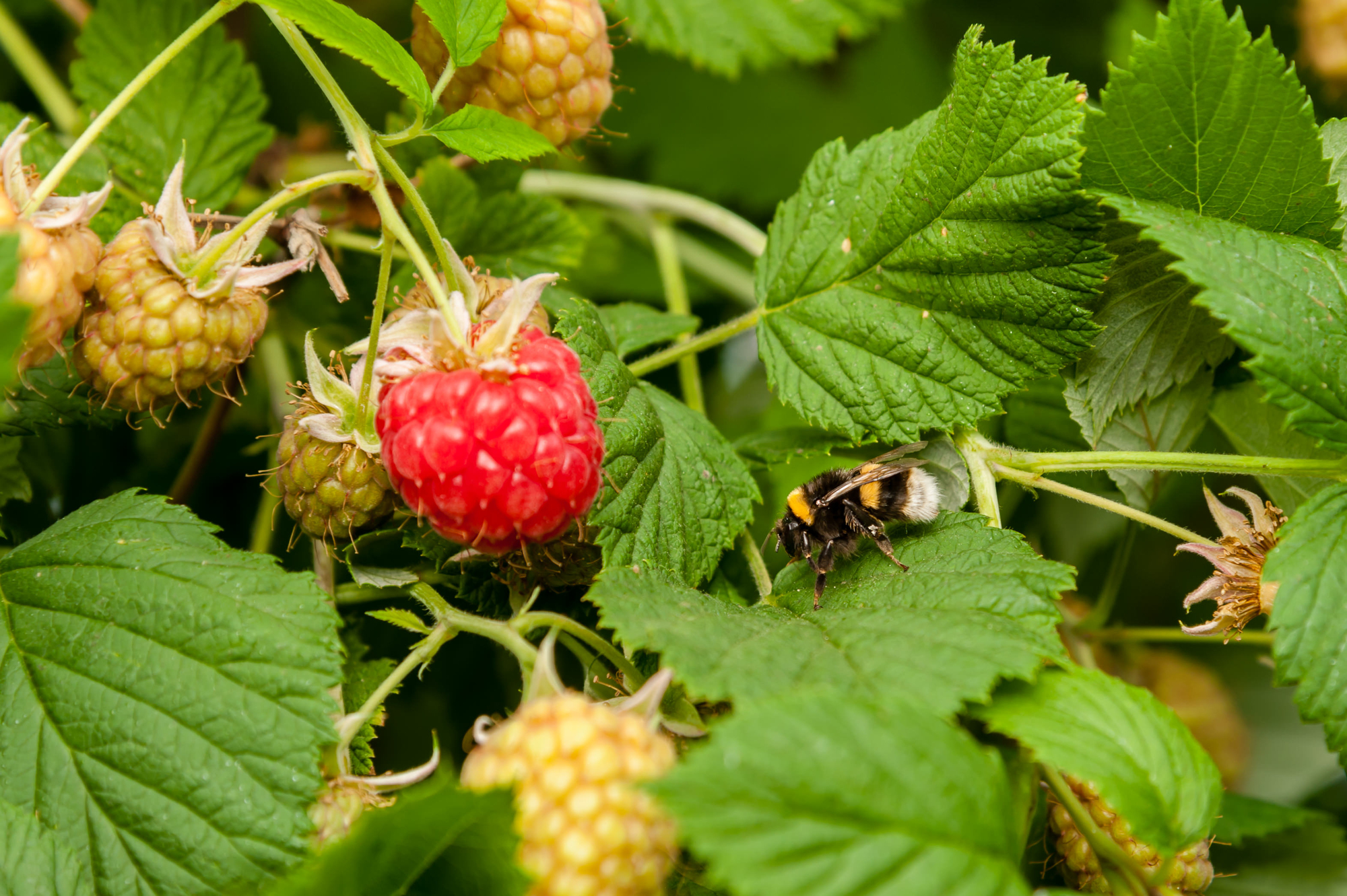Berry Donation Tracker
Quick Links: How & Where to Grow | Temperature | How to Care For | Harvest Signs | Harvesting | Pruning | Pests | Companions | Varieties | Preservation | Recipes | Michigan Tips | Fun Facts
🌱 How & Where to Grow Raspberries:
- Plant bare-root or potted canes in early spring as soon as soil can be worked.
- Space plants 2-3 feet apart in rows 6-8 feet apart.
- Install trellis system at planting – T-posts with wires work best.
- Choose location carefully – raspberries spread by underground runners!
- Sunlight: Full sun (6-8 hours) for best production, tolerates partial shade.
- Soil Type: Well-drained, slightly acidic soil with pH 5.5-6.5.
- Soil Amendment: Rich in organic matter – add compost generously.
Plant raspberries where you want them forever – they’re hard to remove once established!
🌡️ Temperature Guidance:
Need 800-1,700 chill hours. Hardy to -20°F. Heat stress above 85°F.
- Winter chill: Required for proper fruiting – Michigan easily provides.
- Spring growth: Begins when soil reaches 40°F.
- Optimal fruiting: 70-75°F days, cool nights.
- Summer stress: Production slows above 85°F.
- Fall-bearing types can fruit until hard freeze!
Michigan’s climate is ideal – our cool springs and moderate summers produce sweet berries!
💧 How to Care for:
- Consistent Moisture: Critical during flowering and fruiting – 1-2 inches weekly.
- Watering: Use drip irrigation or soaker hoses to keep foliage dry.
- Mulch: 3-4 inches of wood chips to suppress weeds and retain moisture.
- Fertilizer: Early spring application of 10-10-10 or compost.
- Weed control: Essential – raspberries don’t compete well with weeds.
📏 Harvest Signs:
Deep color, easy release, slight softness. Harvest every 2-3 days.
- Color: Full color development for variety (red, black, purple, gold).
- Release test: Ripe berries slip off receptacle with gentle pull.
- Firmness: Slight give when gently squeezed.
- Timing: Morning harvest after dew dries is best.
- Peak production lasts 3-4 weeks for summer types.
Unlike blackberries, ripe raspberries leave the white core on the plant!
🧺 Harvesting:
Handle gently – berries are fragile! Use shallow containers. Cool immediately.
- Gentle touch: Roll berries off with thumb and fingers.
- Container depth: No more than 3 layers deep to prevent crushing.
- Don’t overfill: Transfer to additional containers rather than pile high.
- Cool quickly: Get berries into refrigeration within 2 hours.
- Don’t wash: Until ready to use – moisture causes quick spoilage.
✂️ Pruning:
Summer-bearing: fruit on 2-year canes. Fall-bearing: fruit on 1-year canes.
- Summer-bearing: After fruiting, cut fruited canes to ground. Keep 6-8 new canes per foot.
- Fall-bearing option 1: Cut ALL canes to ground in late winter (one fall crop).
- Fall-bearing option 2: Prune like summer types for two smaller crops.
- Thin new growth: Keep strongest canes, remove weak/damaged.
- Height control: Top at 5-6 feet to prevent flopping.
🪲 Michigan Pests:
Japanese beetles, cane borers, anthracnose, viruses.
- Japanese beetles: Skeletonize leaves – hand-pick or use row covers.
- Cane borers: Tips wilt – prune below damage and destroy.
- Anthracnose: Purple spots on canes – improve air circulation.
- Spotted wing drosophila: New pest – harvest promptly when ripe.
- Viruses: Buy certified disease-free plants, remove infected plants.
🫱🏽🫲🏼 Companions:
Good with garlic, tansy, yarrow. Avoid nightshades, strawberries.
- Garlic: Deters Japanese beetles and improves plant health.
- Tansy: Repels ants and Japanese beetles.
- Yarrow: Attracts beneficial insects.
- Avoid nightshades: Share verticillium wilt susceptibility.
- Keep away from: Wild brambles which harbor diseases.
🌿 Varieties:
Summer: ‘Latham’, ‘Nova’. Fall: ‘Heritage’, ‘Caroline’. Black: ‘Jewel’.
- ‘Latham’: Summer, very cold hardy, classic red raspberry.
- ‘Nova’: Summer, early season, disease resistant.
- ‘Heritage’: Fall, most popular ever-bearing, reliable.
- ‘Caroline’: Fall, large berries, excellent flavor.
- ‘Jewel’: Black raspberry, early summer, unique flavor.
- ‘Anne’: Fall, golden berries, sweet and mild.
🫙 Preservation:
Freeze unwashed on trays. Make jam. Dehydrate. Fresh only 2-3 days.
- Freezing: Spread unwashed berries on trays, freeze solid, then bag.
- Fresh storage: Refrigerate in shallow containers only 2-3 days.
- Jam/jelly: Classic preservation method – follow tested recipes.
- Dehydrating: Makes intensely flavored “chips.”
- Liqueur: Steep berries in vodka with sugar for cordial.
🧑🏽🍳 Recipes:
Fresh eating, raspberry pie, jam, vinaigrette, chocolate combination.
- Nothing beats fresh raspberries with cream!
- Raspberry pie with lattice crust.
- Raspberry vinaigrette for summer salads.
- Chocolate-raspberry tart – classic combination.
- Raspberry lemonade or iced tea.
✋🏼 Michigan Tips:
- Fall-bearing varieties extend season into October.
- Plant different types for June through October harvest.
- Michigan’s humidity requires good air circulation – don’t crowd plants.
- Raised beds improve drainage in heavy clay soils.
- Snow provides natural winter mulch protection.
- Join Michigan Bramble Growers for local advice.
🧠 Fun Facts:
- Each raspberry is actually a cluster of 75-85 tiny fruits!
- Raspberries come in red, black, purple, and golden varieties.
- Black raspberries are native to North America.
- Russia is the world’s largest raspberry producer.
- Raspberries have more vitamin C than oranges.
- The leaves make medicinal tea used for centuries.
- Plants can produce for 15-20 years with proper care.
- Scotland’s climate is so perfect for raspberries they’re the national fruit!


0 Comments